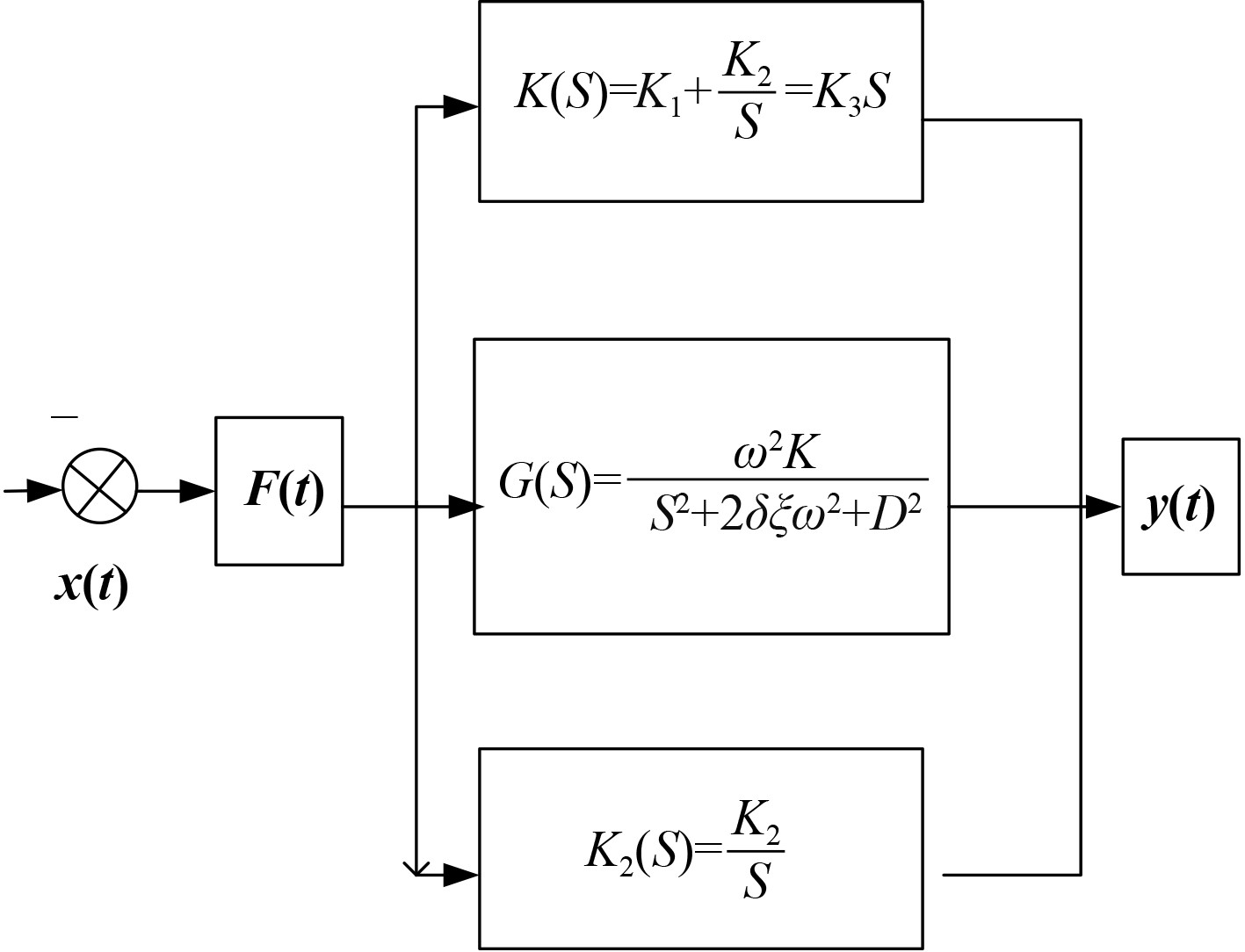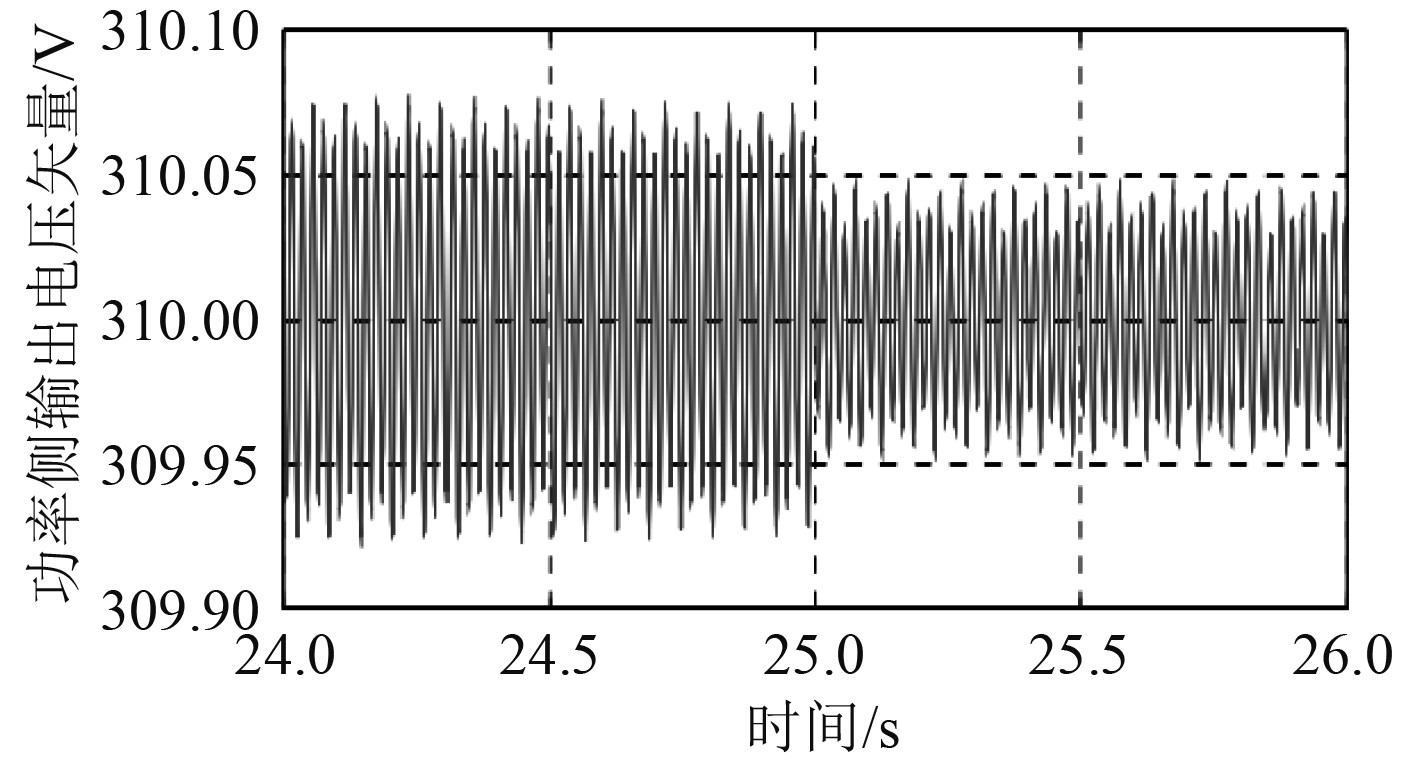船舶货物吊装的工作场景包括:
1)海上作业平台的货物转运
海洋蕴藏丰富的石油、天然气资源,为了开发这些资源,建立了多种用途的海上作业平台,如钻井平台等,这些资源开采后通过大型船舶运输至陆地,转运过程需要借助大吨位吊机进行货物转运。
2)港口装卸货物
大型集装箱船的货物装卸需要借助港口吊机,货物在船舶甲板的搬运需要借助自身吊机。
船舶吊运货物通常使用吊运机械臂完成,当船体受到海浪冲击作用和海风干扰时,一方面,船体本身的纵摇、横摇运动会引起吊运机械臂基座的运动,这种非惯性运动使得机械臂承受更大的载荷,对机械臂和基座的强度带来了挑战;另一方面,由于吊运机械臂本身具有多自由度的运动,叠加船体自身的运动,机械臂与货物会产生更大幅度的晃动,影响货物吊运的安全性。当货物吊运过程出现碰撞等事故时,会对货物和船体造成严重的冲击。
为此,本文研究一种海浪环境下的船舶吊运机械臂运动补偿控制系统,该系统的关键作用是进行波浪环境下的吊运机械臂运动补偿,提高吊运机械臂的稳定性。
1 海浪环境下的船舶吊运机械臂运动建模船舶吊运过程中影响最大的环境因素是海浪作用力,为了提高吊运机械臂的建模精度,对海浪特性进行详细研究。
海浪运动是一种不规则波运动,在进行海浪运动建模时可以只考虑单一方向上的海浪传播特性,将复杂的海浪运动分解为不同规则波的叠加。
建立海浪特性方程:
| $ \xi (t) = \sum\limits_{i = 1}^n {{\xi _0}(t)\cos ({w_0}t + \varphi )} \text{。} $ |
式中:
建立能谱密度方程[2]:
| $ E({\omega _0}) = \frac{{{k_1}}}{{{\omega _0}^3}}\exp (\frac{{ - {k_2}}}{{{\omega _0}^4}}) \text{。} $ |
式中:k1为能谱密度系数,k1=7.9×10−3 g2;
将波浪的速度场在2个方向上分解,可以得到:
| $ \begin{gathered} {E_x}{\text{ = }}\frac{\text π }{2}{\varphi _0}{\theta ^{kt}}\cos \left( {kx - {w_0}t} \right), \\ {E_y} = \frac{1}{2}{\varphi _0}{\theta ^{kt}}\sin \left( {kx - {w_0}t} \right)。\\ \end{gathered} $ |
式中,
建立船舶吊运机械臂在海浪环境下的运动坐标系如图1所示。

|
图 1 船舶吊运机械臂在海浪环境下的运动坐标系 Fig. 1 The moving coordinate system of ship lifting manipulator in sea wave environment |
| $ {I_z}\frac{{{\rm{d}}{w_z}}}{{{\rm{d}}t}} = {M_z} + {M_{sp}} \text{。} $ |
式中:
建立机械臂的运动学方程如下式:
| $ \begin{aligned} & {m\frac{{{\rm{d}}v}}{{{\rm{d}}t}} = P\cos \left( {\alpha + \theta } \right) - Q - mg\sin \theta } ,\\ & {m\frac{{{\rm{d}}\theta }}{{{\rm{d}}t}} = P\sin \left( {\alpha + \theta } \right) - mg\cos \theta }, \\ & {{I_z}\frac{{{\rm{d}}{w_z}}}{{{\rm{d}}t}} = {M_z} + {M_{sp}}} ,\\ & {\frac{{{\rm{d}}x}}{{{\rm{d}}t}} = v\cos \theta }, \\ & {\frac{{{\rm{d}}h}}{{{\rm{d}}t}} = v\sin \theta } \text{。} \end{aligned} $ |
式中:
建立瞬时运动速度模型为:
| $ \begin{gathered} X(t) = \sum\limits_{i = 1}^n {\left[ {{h_x}/n \cdot \cos \left( {{\omega _i}t + {\gamma _{xi}}} \right)} \right]}, \\[2.5pt] Y(t) = \sum\limits_{i = 1}^n {\left[ {{h_y}/n \cdot \cos \left( {{\omega _i}t + {\gamma _{ji}}} \right)} \right]} , \\[2.5pt] Z(t) = \sum\limits_{i = 1}^n {\left[ {{h_z}/n \cdot \cos \left( {{\omega _i}t + {\gamma _{zi}}} \right)} \right]}。\\ \end{gathered} $ |
式中:
3个坐标轴的角度模型为:
| $ \begin{gathered} \gamma = \sum\limits_{i = 1}^n {\left[ {{A_r}/n \cdot \sin \left( {{\omega _r}t + {\varphi _r}} \right)} \right]}, \\[2.5pt] \theta = \sum\limits_{i = 1}^n {\left[ {{A_\theta }/n \cdot \sin \left( {{\omega _\theta }t + {\varphi _\theta }} \right)} \right]}, \\[2.5pt] \psi = \sum\limits_{i = 1}^n {\left[ {{A_\psi }/n \cdot \sin \left( {{\omega _\psi }t + {\varphi _\varphi }} \right)} \right]}。\\ \end{gathered} $ |
式中:
针对船舶吊运机械臂的运动补偿控制器,利用PID控制器建立一种自适应控制系统。
PID控制器是一种应用广泛、可靠性高的反馈控制器,包括积分控制、微分控制和比例控制3部分,对于改善系统的稳态误差、非线性误差等效果明显,图2为PID控制器的原理。

|
图 2 PID控制器原理图 Fig. 2 Schematic diagram of PID controller |
PID控制器的工作流程包括:
1) 确定被控系统的信号采集周期;
2)利用比例控制和阶跃响应信号,确定PID控制器的比例放大系数
3)利用积分和微分控制环节,调节被控系统的信号超调量。
PID控制器的数学模型为:
| $ K(S) = {K_1} + \frac{{{K_2}}}{S} + {K_3}S \text{。} $ |
式中:
PID控制器的传递函数为:
| $ G(S) = \frac{{{\omega ^2}K}}{{{S^2} + 2\delta \xi {\omega ^2} + {D^2}}} \text{。} $ |
式中:
针对船舶机械臂的运动补偿,设计一种六自由度补偿机构,通过电机控制补偿机构上下平台的偏移量实现波浪运动的补偿。
图3为吊运机械臂运动补偿机构的原理图。

|
图 3 吊运机械臂运动补偿机构的原理图 Fig. 3 The principle diagram of the motion compensation mechanism of the lifting manipulator |
六自由度补偿机械的关键控制环节是机械的电机伺服控制,本文使用三相永磁同步电机作为波浪补偿结构的动力来源。
建立三相永磁同步电机的电压方程如下:
| $ \left[ {\begin{array}{*{20}{l}} {{u_a}} \\ {{u_b}} \\ {{u_c}} \end{array}} \right] = \left[ {\begin{array}{*{20}{c}} {{R_s}}&0&0 \\ 0&{{R_s}}&0 \\ 0&0&{{R_s}} \end{array}} \right]\left[ {\begin{array}{*{20}{l}} {{i_a}} \\ {{i_b}} \\ {{i_c}} \end{array}} \right] + p\left[ {\begin{array}{*{20}{c}} {{\varphi _a}} \\ {{\varphi _b}} \\ {{\varphi _c}} \end{array}} \right] \text{。} $ |
式中:
磁链方程为:
| $ \left[ {\begin{array}{*{20}{c}} {{\varphi _a}}\\ {{\varphi _b}}\\ {{\varphi _c}} \end{array}} \right] = \left[ {\begin{array}{*{20}{l}} {{L_{aa}}}&{{M_{ab}}}&{{M_{ac}}}\\ {{M_{ba}}}&{{L_{bb}}}&{{M_{bc}}}\\ {{M_{ca}}}&{{M_{cb}}}&{{L_{cc}}} \end{array}} \right]\left[ {\begin{array}{*{20}{l}} {{i_a}}\\ {{b_b}}\\ {{i_c}} \end{array}} \right] + {\varphi _r}\left[ {\begin{array}{*{20}{c}} {\cos \theta }\\ {\cos \left( {\theta - 120^\circ } \right)}\\ {\cos \left( {\theta + 120^\circ } \right)} \end{array}} \right]。$ |
式中:
本文使用的电机参数如表1所示。
|
|
表 1 电机参数表 Tab.1 Motor parameter table |
图4为波浪补偿机构电机输出电压矢量图。

|
图 4 波浪补偿机构电机输出电压矢量图 Fig. 4 Wave compensation mechanism motor output voltage vector diagram |
结合PID控制器,针对船舶吊运机械臂的波浪补偿控制进行开发,吊运机械臂的波浪补偿控制系统原理图如图5所示。

|
图 5 吊运机械臂的波浪补偿控制系统原理图 Fig. 5 Schematic diagram of wave compensation control system for lifting manipulator |
可知,波浪补偿控制器基于PID控制原理,接收运动模型的参数,控制电动机的转矩信号,然后通过执行器进行补偿平台的控制。同时,系统位置传感器采集吊运机械臂和船体的横摇等运动参数,作为负反馈信号输入PID控制器中[4]。
建立三相永磁同步电机的控制信号为:
| $ \begin{aligned} & {{u_a}{\text{ = }}{U_0}\cos wt}, \\ & {{u_b} = {U_0}\left( {\cos wt - {\raise0.7ex\hbox{${2{\text π} }$} \mathord{\left/ {\vphantom {{2{\text π} } 3}}\right.} \lower0.7ex\hbox{$3$}}} \right)}, \\ & {{u_c} = {U_0}\left( {\cos wt + {\raise0.7ex\hbox{${2{\text π} }$} \mathord{\left/ {\vphantom {{2{\text π} } 3}}\right.} \lower0.7ex\hbox{$3$}}} \right)}。\end{aligned} $ |
根据PID控制器原理,确定永磁同步电动机的控制精度为
确定PID控制器的放大系数
最后,结合位置传感器的信息实现吊运机械臂的运动补偿控制。
本文在Simulink中进行波浪补偿前后的吊运机械臂位移量仿真,得到曲线如图6所示(曲线1为补偿前,曲线2为补偿后)。

|
图 6 波浪补偿前后的吊运机械臂位移量仿真 Fig. 6 Simulation of displacement of lifting manipulator before and after wave compensation |
船舶吊运机械臂的稳定性对于货物与船体的安全十分重要,因此,在进行船舶吊运机械臂设计时,有必要考虑船体的波浪补偿控制。本文介绍吊运机械臂的力学特性,建立一种六自由度运动补偿机制,针对系统的电机控制引入PID控制技术,取得了良好的效果。
| [1] |
秦小健, 吴垠峰, 钱正宏, 等. 波浪运动补偿装置的研究现状与发展趋势[J]. 中国水运, 2022(12): 104-106. QIN Xiao-jian, WU Yin-feng, QIAN Zheng-hong, et al. Research status and development trend of wave motion compensation device[J]. China Water Transport, 2022(12): 104-106. DOI:10.13646/j.cnki.42-1395/u.2022.12.039 |
| [2] |
丁明, 孟帅, 王书恒, 等. 六自由度波浪补偿平台的神经网络自适应反馈线性化控制[J]. 上海交通大学学报, 2022, 56(2): 165-172. DING Ming, MENG Shuai, WANG Shu-heng, XIA Xi. Adaptive feedback linearization control of neural network for six-degree-of-freedom wave compensation platform[J]. Journal of Shanghai Jiao Tong University, 2022, 56(2): 165-172. DOI:10.16183/j.cnki.jsjtu.2020.424 |
| [3] |
李欢, 樊春明, 李鹏, 等. 浮式波浪补偿装置研究及发展建议[J]. 石油机械, 2022, 50(2): 53-58+65. LI Huan, FAN Chun-ming, LI Peng, et al. Research and development suggestions of floating wave compensation device[J]. Petroleum Machinery, 2022, 50(2): 53-58+65. |
| [4] |
陈原, 郭登辉, 田丽霞. 绳牵引刚柔式波浪补偿并联机构的设计与建模[J]. 浙江大学学报(工学版), 2021, 55(5): 810-822. CHEN Yuan, GUO Deng-hui, TIAN Li-xia. Design and modeling of rope-traction rigid-flexible wave compensation parallel mechanism[J]. Journal of Zhejiang University(Engineering Science), 2021, 55(5): 810-822. |
 2023, Vol. 45
2023, Vol. 45
